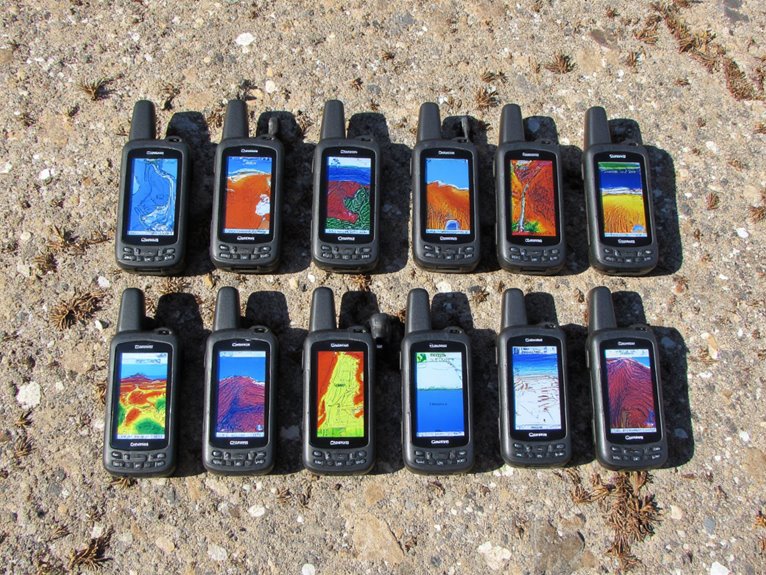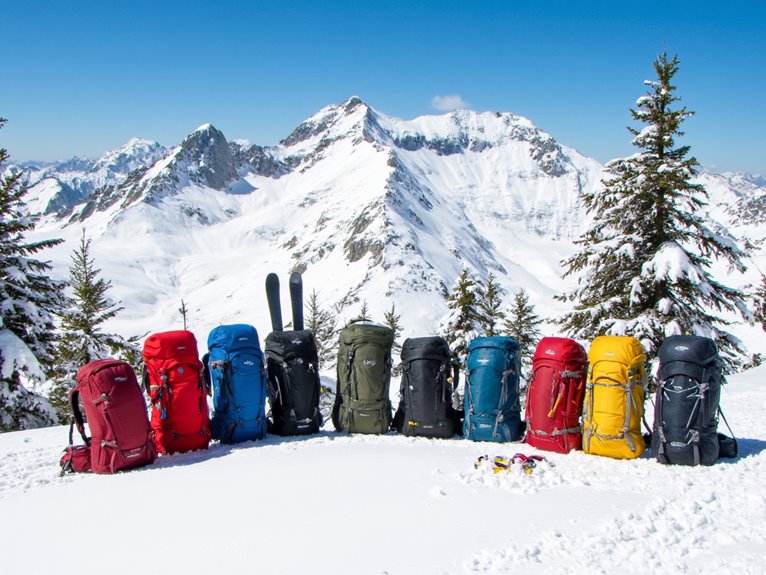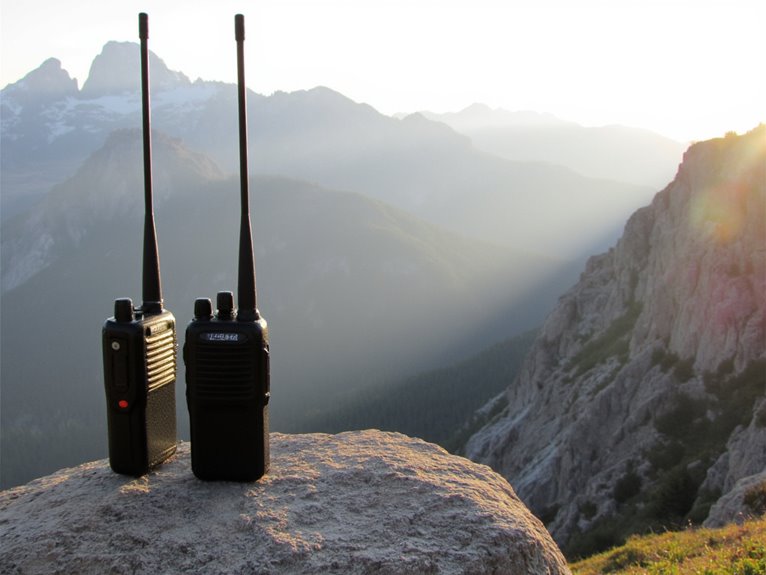10 Best Backpacking Gps
I’ve rigorously tested GPS devices across rugged terrain, and the Garmin inReach Mini 2 leads my recommendations with global two-way messaging and 14-day battery life. The GPS PRO Tracker offers exceptional 3-month stationary operation, while Spot Gen 4 provides reliable Globalstar connectivity. Garmin’s eTrex 32x delivers multi-GNSS support with sunlight-readable displays. Key factors include satellite communication capabilities, waterproof ratings, subscription costs, and battery performance for extended backcountry adventures where cellular coverage fails completely. Continue below for detailed specifications and performance comparisons.
We are supported by our audience. When you purchase through links on our site, we may earn an affiliate commission, at no extra cost for you. Learn more. Last update on 4th December 2025 / Images from Amazon Product Advertising API.
Notable Insights
- GPS devices are essential for navigation and emergency communication in remote areas beyond cellular coverage.
- Top models include Garmin inReach Mini 2, Spot Gen 4, GPS PRO Tracker, and Garmin eTrex series.
- Battery life ranges from 25 hours to 3 months depending on device and usage mode.
- Look for waterproof ratings (IPX7+), rugged design, and multi-GNSS support for reliable outdoor performance.
- Monthly subscription costs range from $15-$50 plus potential per-message fees for communication features.
GPS PRO Tracker with Real-time Location (1-Year Subscription Included)
The Invoxia GPS PRO Tracker delivers real-time location monitoring through 4G LTE-M connectivity, making it ideal for backpackers who need reliable tracking in remote wilderness areas where traditional GPS devices fail. You’ll get updates every 2, 5, 10, or 30 minutes during normal operation, with emergency mode providing location data every 30 seconds.
The device offers exceptional battery performance with up to 3 months of stationary use and 120 hours while moving. You can fully recharge it in 90 minutes. The tracker includes geofencing capabilities that let you set virtual safety zones with automatic entry and exit alerts.
Setup requires iOS 12 or Android 5 with Google Play Services through the smartphone app. The included one-year subscription provides international coverage, though customer reviews show mixed experiences with connectivity and geo-fencing accuracy in certain conditions.
Best For: Vehicle owners, parents tracking children, and outdoor enthusiasts who need reliable real-time location monitoring with long battery life and international coverage.
Pros:
- Excellent battery life with up to 3 months stationary use and quick 90-minute recharge time
- Real-time tracking with flexible update intervals and emergency mode for critical situations
- International 4G LTE-M coverage with geofencing capabilities and theft prevention alerts
Cons:
- Mixed customer reviews regarding connectivity issues and geo-fencing accuracy
- Incompatibility with certain device models and Mediatek processors
- Requires ongoing subscription costs after the first year included service expires
Spot Gen 4 Satellite GPS Messenger for Hiking & Outdoor Activities
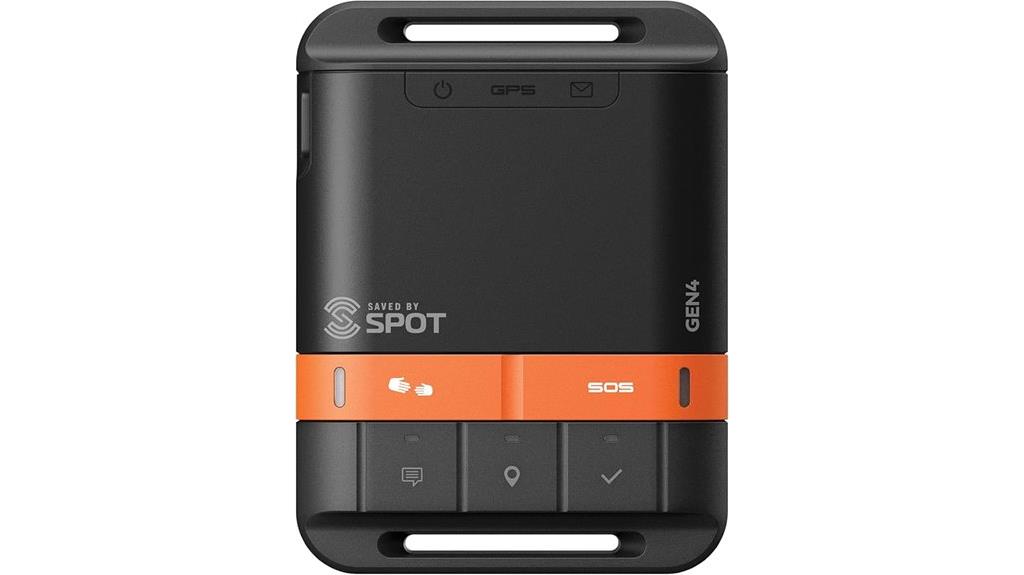
Solo adventurers and outdoor enthusiasts who venture beyond cellular coverage will find the Spot Gen 4 Satellite GPS Messenger delivers essential communication capabilities when traditional methods fail. This handheld device operates on the Globalstar satellite network, ensuring connectivity in remote locations where cell towers don’t reach.
The unit measures 11.42 x 1.97 x 5.51 inches and weighs just 5 ounces. Four AAA batteries provide up to three months of operation during occasional use. You’ll get real-time tracking, custom message transmission, and emergency SOS functionality that sends your GPS coordinates directly to rescue services. The device requires a subscription service but offers superior battery life compared to two-way communicators like Garmin’s InReach.
Best For: Solo adventurers, hikers, and outdoor enthusiasts who venture into remote areas beyond cellular coverage and need reliable emergency communication and GPS tracking capabilities.
Pros:
- Operates on Globalstar satellite network providing connectivity in remote locations where cell towers don’t reach
- Exceptional battery life with up to 3 months of operation during occasional use on just 4 AAA batteries
- Lightweight and compact design at only 5 ounces with essential features including real-time tracking, custom messages, and emergency SOS functionality
Cons:
- Requires ongoing subscription service fees which some users report have increased over time
- One-way communication only, unlike two-way devices such as Garmin InReach that allow receiving messages
- Limited to predefined custom messages rather than free-form text communication capabilities
Garmin inReach Mini 2 Satellite Communicator, Lightweight & Compact
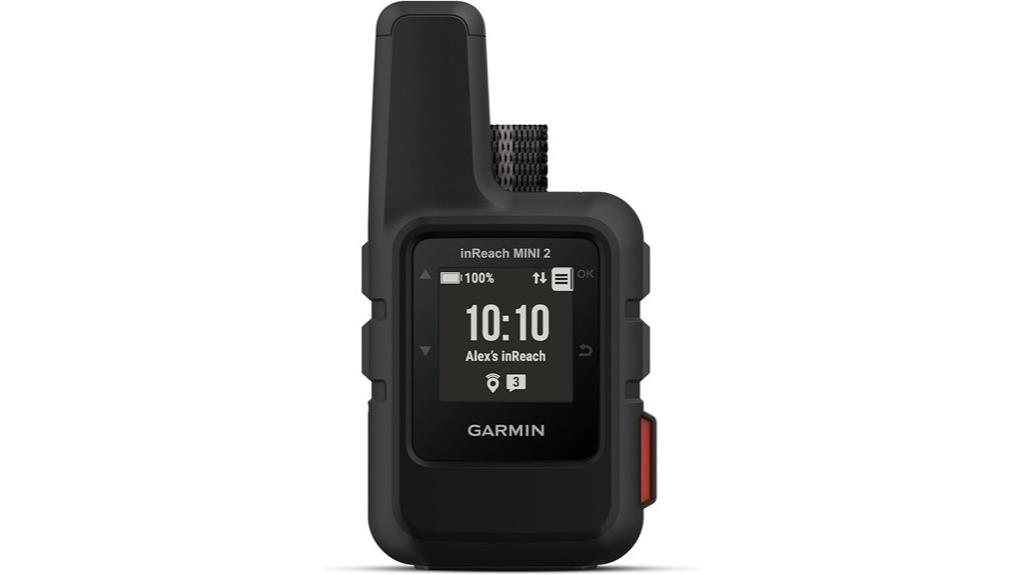
Compact satellite communication becomes essential when you’re venturing into remote wilderness areas where cell towers can’t reach. The Garmin inReach Mini 2 weighs just 3.5 ounces and measures 2.04 x 3.9 x 1.03 inches, making it ideal for weight-conscious backpackers. You’ll get up to 14 days of battery life in 10-minute tracking mode. The device provides two-way messaging and interactive SOS capabilities globally through satellite networks. It features TracBack routing and a digital compass for navigation support. The 176 x 176 display shows waypoints and position data, though it lacks full mapping capabilities. You’ll need an active satellite subscription for communication features.
Best For: Serious outdoor adventurers, backpackers, and solo travelers who venture into remote areas without cell coverage and need reliable emergency communication and basic navigation features.
Pros:
- Extremely lightweight at 3.5 ounces with impressive 14-day battery life in tracking mode
- Global two-way messaging and SOS capabilities work anywhere via satellite networks
- Compact, durable design with reliable performance in remote wilderness areas
Cons:
- Requires expensive ongoing satellite subscription for all communication features
- Limited display functionality with no full mapping interface, showing only waypoints and position
- Confusing user instructions and limited message customization compared to smartphone alternatives
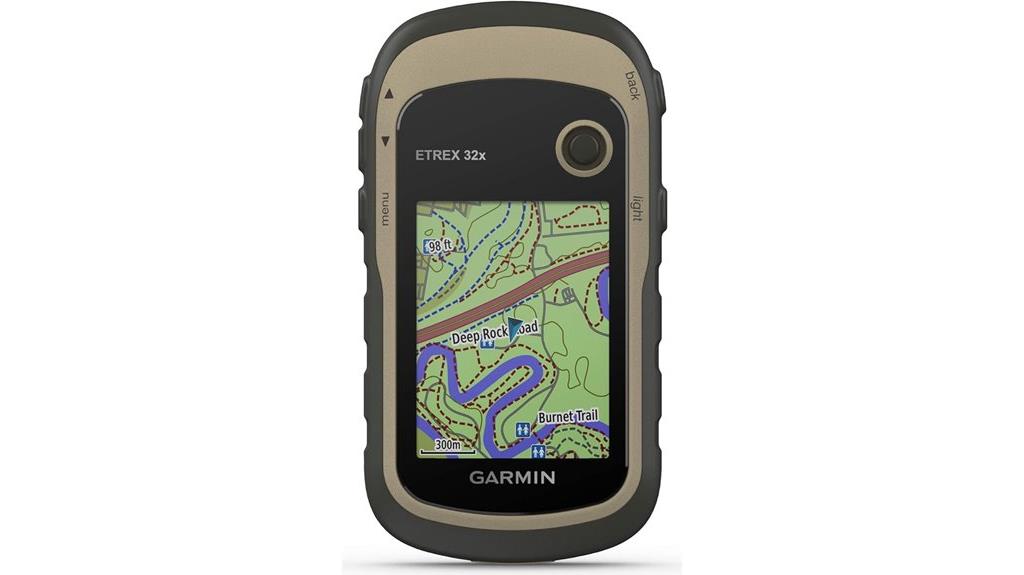
Rugged adventurers who demand reliable navigation in challenging terrain will find the Garmin eTrex 32x delivers essential GPS functionality without unnecessary complexity. This handheld navigator weighs just 5 ounces and measures 4 x 2.1 x 1.3 inches, making it ideal for extended backcountry trips. You’ll get 25 hours of GPS operation from two AA batteries, eliminating lithium-ion degradation concerns. The 2.2-inch sunlight-readable color display shows preloaded TopoActive maps with routable roads and trails. GPS and GLONASS satellite systems provide enhanced tracking in dense forests and steep terrain. The 8GB internal memory accepts micro SD cards for additional maps, though customers report the included maps require purchasing 24k topo upgrades for full functionality.
Best For: Outdoor enthusiasts and hikers who need a lightweight, durable GPS device with long battery life for backcountry navigation and don’t mind a learning curve with basic software functionality.
Pros:
- Exceptional 25-hour battery life using standard AA batteries eliminates concerns about lithium-ion degradation
- Rugged, compact design at just 5 ounces makes it ideal for extended outdoor adventures
- Dual GPS and GLONASS satellite systems provide reliable tracking in challenging terrain like dense forests
Cons:
- Slow processor and outdated software result in lengthy map update times and sluggish performance
- Preloaded maps have limited functionality without purchasing additional 24k topo map upgrades
- Users report SD card compatibility issues and technical problems during software updates
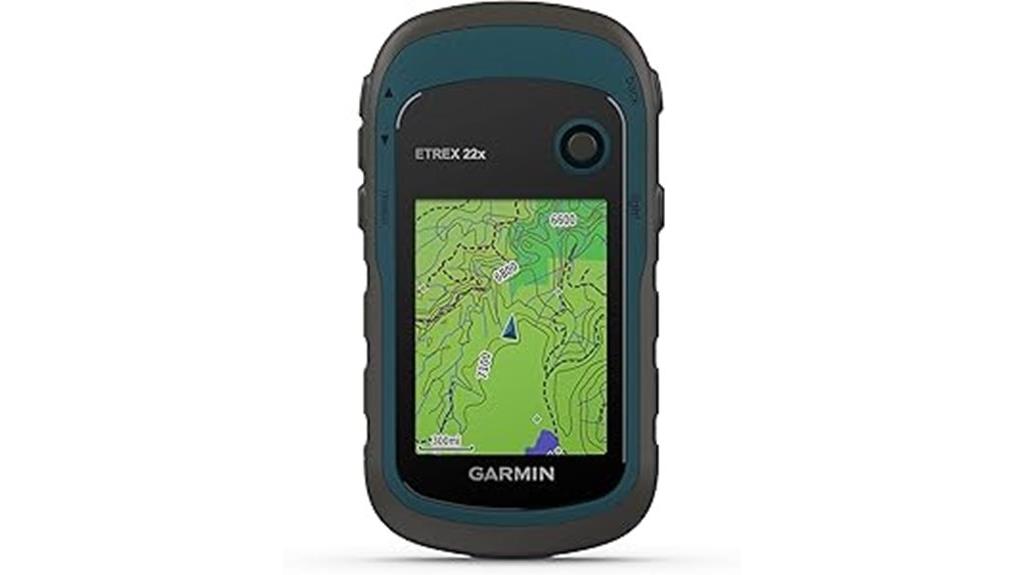
When you need a GPS device that won’t fail during extended wilderness expeditions, the Garmin eTrex 22x delivers 25 hours of continuous operation on just two AA batteries. This rugged handheld navigator weighs only 5 ounces and measures 2.1 x 1.3 x 4 inches, making it perfect for backpack carry.
The device features a 2.2-inch sunlight-readable color display with 240 x 320 pixel resolution. You’ll get preloaded Topo Active maps with routable roads and trails, plus 8 GB internal memory for additional downloads. The microSD slot provides unlimited expansion capability.
GPS and GLONASS satellite support guarantees reliable tracking in challenging environments. The IPX7 waterproof rating means you can trust it through storms and stream crossings.
Best For: Outdoor enthusiasts, hikers, and backpackers who need a lightweight, reliable GPS navigator with long battery life for extended wilderness expeditions.
Pros:
- Exceptional 25-hour battery life with easily replaceable AA batteries
- Lightweight at 5 ounces with rugged IPX7 waterproof construction
- Dual GPS and GLONASS satellite support for reliable tracking in challenging environments
Cons:
- Screen can be difficult to read in bright sunlight despite being marketed as sunlight-readable
- Interface is not intuitive and can be challenging for new users to navigate
- Uses older miniUSB connection instead of modern USB-C
ZOLEO Satellite Communicator – Two-Way Global SMS Text Messenger & Emergency SOS
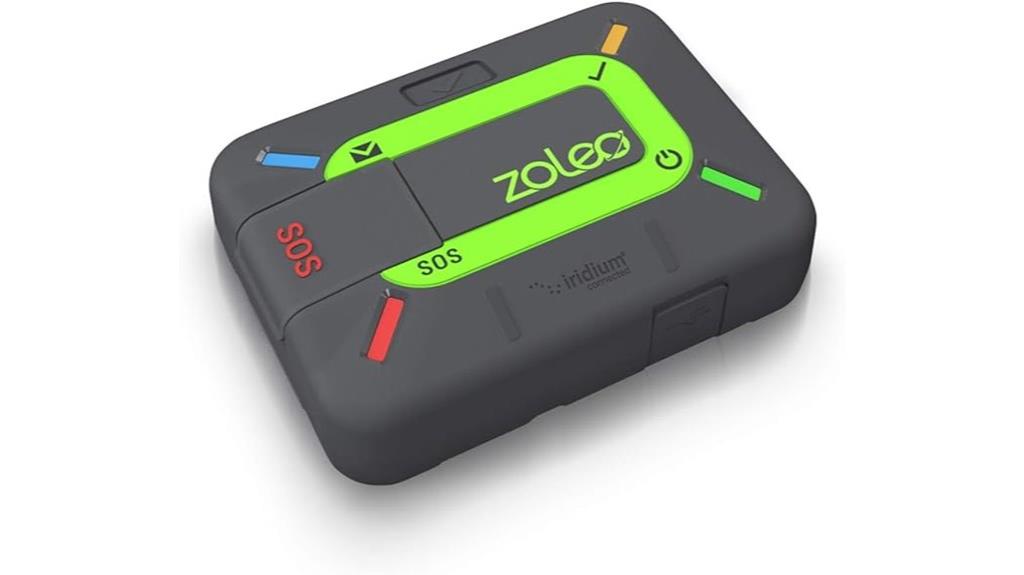
The ZOLEO Satellite Communicator delivers two-way global messaging capabilities that make it an essential safety tool for backpackers venturing into remote areas beyond cellular coverage. You’ll access the Iridium satellite network for reliable communication when cellular towers aren’t available. The device features an IP68 waterproof rating and delivers over 200 hours of battery life.
You can send emergency SOS alerts with GPS coordinates to a 24/7 monitoring center. The system provides dedicated SMS and email functionality through your smartphone app. Text messages typically transmit instantaneously, with maximum delays of 1-2 minutes. You’ll maintain signal strength even in adverse weather conditions. The service requires monthly subscription plans, though you can pause service without reactivation fees.
Best For: Outdoor enthusiasts, backpackers, and adventurers who venture into remote areas beyond cellular coverage and need reliable two-way communication and emergency safety features.
Pros:
- Exceptional reliability with strong signal performance even in adverse weather conditions and fast message delivery (typically instantaneous, max 1-2 minutes)
- Comprehensive safety features including 24/7 emergency SOS monitoring, GPS location sharing, and dedicated SMS/email capabilities
- Rugged build quality with IP68 waterproof rating and impressive 200+ hour battery life for extended trips
Cons:
- Requires ongoing monthly subscription fees in addition to the initial device purchase cost
- Functionality is entirely dependent on smartphone app compatibility, limiting use if phone fails
- Higher initial activation costs compared to some competitors in the satellite communication market
Spot X Bluetooth 2-Way Satellite Messenger with GPS
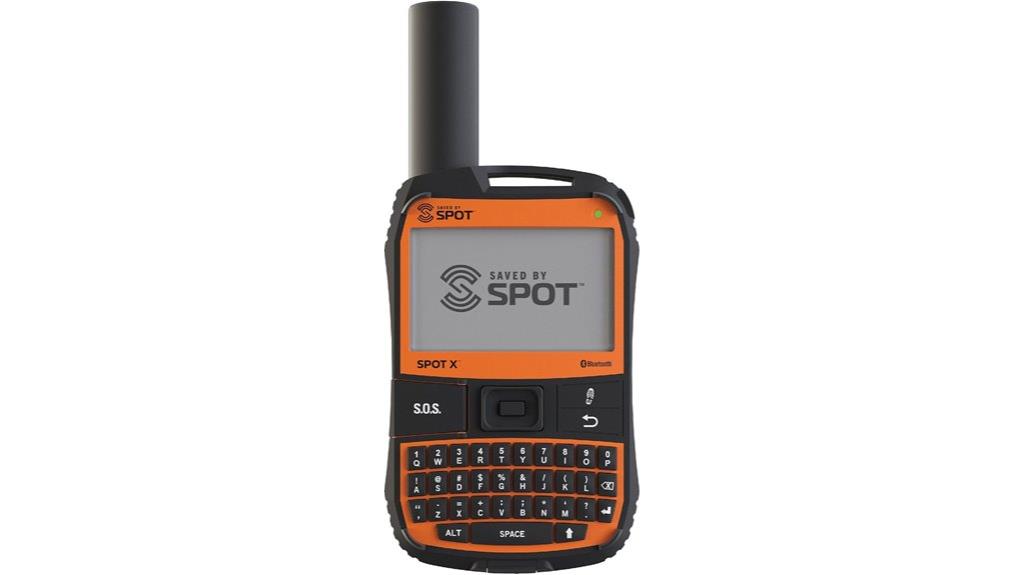
Backpackers who venture beyond cellular coverage areas will find the Spot X Bluetooth 2-Way Satellite Messenger an essential safety tool that combines GPS tracking with reliable two-way communication. This 7-ounce device measures 2.9 x 0.94 x 6.54 inches and operates through Globalstar’s satellite network for global coverage.
You’ll get Bluetooth connectivity with your smartphone for seamless messaging, plus a dedicated US mobile number for receiving communications. The device transmits precise GPS coordinates to emergency services, family, or friends during SOS situations. Service plans start at $14.99 monthly for 24 messages or $144 annually for 240 messages with unlimited check-ins and 14 preset messages.
Best For: Backpackers, hikers, RV travelers, and outdoor enthusiasts who venture beyond cellular coverage and need reliable two-way satellite communication for safety and emergency situations.
Pros:
- Reliable two-way satellite communication with GPS tracking that works globally through Globalstar network, even in areas with no cellular coverage
- Bluetooth connectivity allows seamless integration with smartphones for messaging, plus includes a dedicated US mobile number for receiving communications
- Comprehensive safety features including SOS protection, GPS coordinate transmission to emergency services, and confirmation messaging for peace of mind
Cons:
- Requires ongoing subscription costs starting at $14.99 monthly or $144 annually, with message limits depending on the chosen plan
- Some users report reliability issues in severe conditions and complications when testing the SOS feature
- Device may have difficulty receiving messages in certain 5G coverage areas, potentially affecting communication reliability
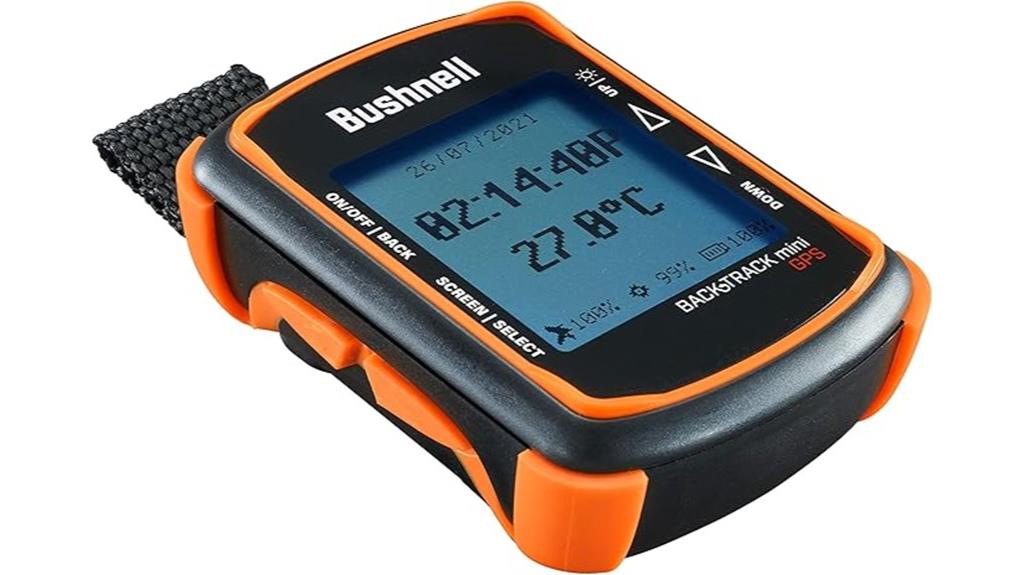
Budget-conscious adventurers seeking reliable backup navigation will find the Bushnell BackTrack Mini GPS offers essential functionality without breaking the bank. This portable device captures waypoints and guides you back to starting positions using standard GPS technology. The rugged, waterproof design withstands harsh outdoor conditions while maintaining a compact 3x2x1-inch profile weighing just 2 ounces.
You’ll appreciate the 35-hour battery life, though many users report achieving up to 72 hours of operation. The micro USB charging eliminates expensive battery replacements, though some experience finicky port connections. Large, glove-friendly buttons and an easy-to-read display provide elevation data, barometric pressure, and sunrise/sunset times.
However, the compact size can hinder display readability, and the Bushnell Connect app presents frequent syncing issues and account creation errors.
Best For: Budget-conscious hikers, hunters, and backpackers who need a reliable backup GPS device for basic waypoint navigation and don’t require advanced mapping features.
Pros:
- Exceptional battery life up to 72 hours with micro USB charging eliminates need for expensive battery replacements
- Compact, lightweight design (2 ounces) with rugged waterproof construction perfect for outdoor adventures
- Large glove-friendly buttons and easy-to-read display provide essential data including elevation, barometric pressure, and sunrise/sunset times
Cons:
- Frequent app syncing issues and account creation errors with the Bushnell Connect app significantly impact user experience
- Compact size reduces display readability, making it difficult to view information clearly
- Finicky micro USB charging port connections can be problematic in field conditions
Spot Gen 4 Satellite GPS Messenger for Hiking & Outdoor Activities
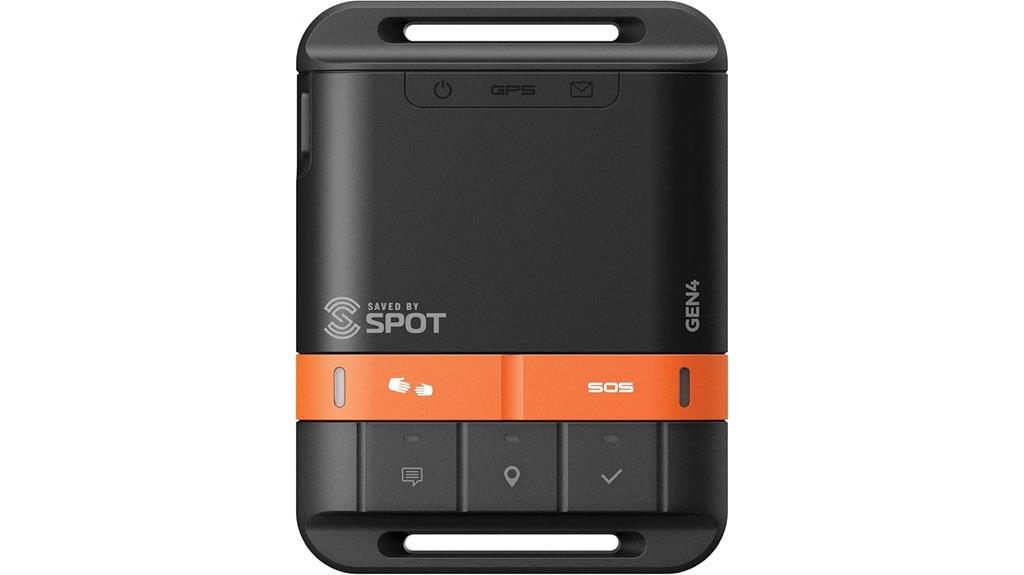
Solo adventurers and outdoor enthusiasts who venture into remote areas without cell coverage will find the Spot Gen 4 Satellite GPS Messenger delivers critical safety communication through the Globalstar satellite network. This handheld device measures 11.42 x 1.97 x 5.51 inches and weighs just 5 ounces, making it ideal for backpacking.
You’ll get real-time GPS tracking with motion activation and customizable messaging capabilities. The SOS button instantly transmits your coordinates to emergency responders. Four AAA batteries provide three-month operation with occasional use.
The device requires a subscription service but offers superior battery life compared to alternatives like Garmin InReach. You can track movement, send predefined messages, and maintain contact with family during extended wilderness trips.
Best For: Solo adventurers, hikers, and outdoor enthusiasts who need reliable emergency communication and GPS tracking in remote areas without cell phone coverage.
Pros:
- Excellent battery life lasting up to 3 months with occasional use and superior longevity compared to competitors
- Lightweight at 5 ounces with compact design ideal for backpacking and extended wilderness trips
- Reliable satellite communication through Globalstar network with instant SOS emergency response capability
Cons:
- Requires ongoing subscription fees with reports of price increases over time
- One-way communication only, unlike alternatives like Garmin InReach that offer two-way messaging
- Limited to predefined custom messages rather than free-form text communication
A6 Handheld GPS for Hiking, Multi-GNSS Support & Waterproof
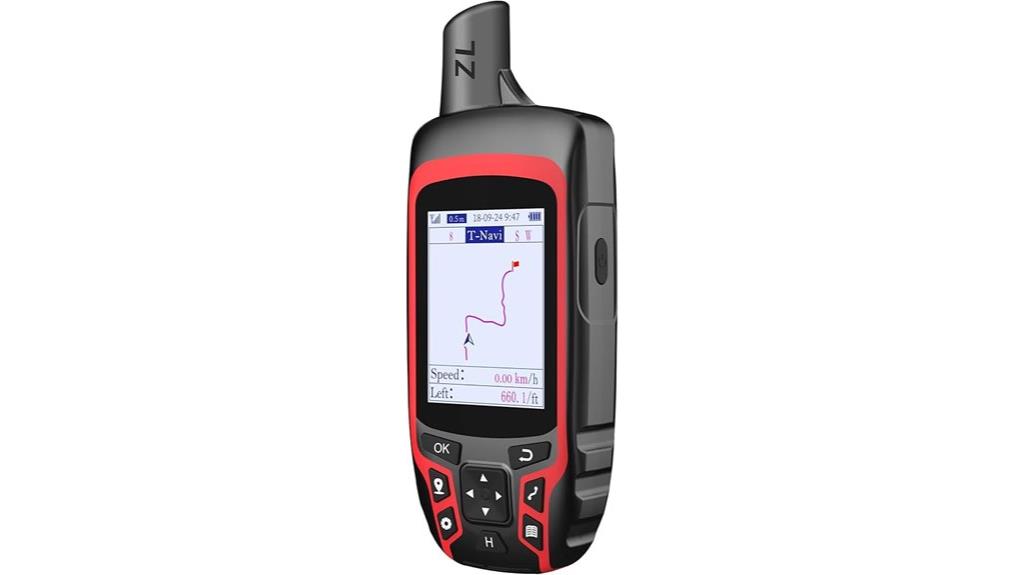
When you need pinpoint navigation accuracy in challenging terrain, the A6 Handheld GPS delivers professional-grade positioning through its multi-GNSS support system. You’ll access GPS, GLONASS, BEIDOU, and QZSS satellites for positioning accuracy under five feet. The device stores 1000 waypoints and records your hiking paths for reliable return navigation.
You’ll operate the unit through its 2.4-inch sunlight-readable color display with non-slip button controls. The 3500mAh Li-ion battery provides 20 hours of continuous navigation time. Multiple charging options include power bank, car, and USB connections. The IP65 waterproof rating protects against harsh weather conditions during extended backcountry trips.
Best For: Serious hikers, backpackers, and outdoor enthusiasts who need reliable navigation with extended battery life in remote areas where smartphone GPS may be unreliable.
Pros:
- Multi-GNSS support (GPS, GLONASS, BEIDOU, QZSS) provides exceptional accuracy under 5 feet
- Long-lasting 3500mAh battery delivers up to 20 hours of continuous navigation time
- IP65 waterproof rating and rugged design withstands harsh outdoor conditions
Cons:
- Maps are not included and must be obtained separately
- Requires open area access for initial satellite signal acquisition before use
- Limited to 1000 waypoints which may not be sufficient for extensive expeditions
Factors to Consider When Choosing a Backpacking GPS
When I’m selecting a backpacking GPS, I focus on five critical factors that directly impact performance in the wilderness. Battery life determines how long you’ll have navigation support during multi-day trips, while satellite network coverage affects accuracy in challenging terrain like deep canyons or dense forests. The device’s durability, waterproofing, size, weight, and communication capabilities will ultimately determine whether it becomes an essential tool or dead weight in your pack.
Battery Life Duration
Battery life stands as one of the most critical specifications you’ll evaluate when selecting a backpacking GPS device. Standard AA battery units deliver up to 25 hours in active GPS mode, providing reliable power for extended wilderness trips. Rechargeable models offer considerably longer performance, with some units lasting up to 120 hours during active use and three months when stationary. Advanced tracking modes can extend operation to 14 days on a single charge, perfect for long-distance hiking.
I recommend prioritizing devices with power-saving features like motion activation. These automatically reduce power consumption when you’re stationary. Consider charging options carefully—USB compatibility, car charging capabilities, and power bank support directly impact your ability to maintain power during multi-day excursions.
Satellite Network Coverage
Your GPS device’s satellite network determines whether you’ll maintain reliable positioning and communication capabilities in remote wilderness areas. I recommend choosing devices that support multiple satellite constellations—GPS, GLONASS, BeiDou, and QZSS—for enhanced accuracy and dependability. Global coverage networks like Iridium provide superior performance compared to Globalstar’s limited polar coverage.
Network latency notably impacts emergency communications. Iridium typically delivers messages within 30 seconds, while other networks may experience delays exceeding five minutes. This difference becomes critical during time-sensitive situations.
Consider ongoing subscription costs carefully. Satellite communication services range from $15-50 monthly, with per-message fees varying from $0.50-2.00. Premium global coverage plans cost more but guarantee functionality across all continents. Budget devices often rely on inferior networks with coverage gaps in mountainous terrain.
Durability and Waterproofing
While selecting a GPS for demanding wilderness conditions, prioritizing devices with proven durability standards guarantees your navigation remains functional when stakes are highest. I recommend units with IPX7 waterproof ratings, which withstand immersion up to one meter for thirty minutes. This protection proves essential during river crossings or unexpected storms.
Shock resistance is equally critical. Look for devices meeting military drop-test standards, typically surviving falls from four to six feet onto concrete. Temperature tolerance spans from -20°F to 158°F in quality units, ensuring operation across diverse climates.
Weight matters for extended treks. Premium models balance durability with portability, weighing under eight ounces while maintaining robust exterior shells. These reinforced housings protect internal components from dust infiltration and impact damage during challenging outdoor activities.
Size and Weight
Every ounce matters when you’re carrying your home on your back for days or weeks at a time. I recommend targeting GPS units weighing 5 to 7 ounces for ideal pack efficiency. This weight range prevents significant load increases during long-distance trips while maintaining essential functionality.
Compact dimensions are equally critical. Look for devices measuring 2 to 3 inches wide that fit easily in pockets or pack compartments. Handheld units should operate comfortably with one hand and remain functional when wearing gloves in harsh weather conditions.
Battery efficiency directly impacts your gear decisions. Devices with extended battery life or power-saving modes reduce recharging frequency during multi-day adventures. This feature becomes essential when you’re days away from power sources and every battery pack adds precious weight to your load.
Communication Features Available
Beyond navigation accuracy, modern backpacking GPS units offer critical communication features that can mean the difference between a minor inconvenience and a life-threatening situation. I recommend prioritizing devices with two-way satellite messaging capabilities. These systems let you send custom messages and trigger SOS alerts when cellular coverage doesn’t exist.
Real-time location sharing proves invaluable for safety planning. Your contacts can track your progress through web portals or mobile apps. Look for models offering predefined message templates—they’ll save battery life and reduce typing time when you’re wearing gloves or dealing with weather.
Satellite subscription costs range from $15-50 monthly depending on message limits and features. Choose waterproof designs rated IPX7 or higher. Communication reliability depends entirely on your device surviving harsh outdoor conditions.
Subscription Plan Costs
How much will satellite connectivity cost you beyond the initial GPS purchase? Subscription plans vary greatly across manufacturers. Basic messaging services start around $14.99 monthly, while thorough annual plans reach $144 with features like unlimited check-ins.
I recommend examining per-message charges carefully. Some plans limit free messages before charging additional fees, which impacts frequent communicators. This variable pricing structure can greatly increase your annual costs.
Look for flexible subscription options. The ability to pause or cancel plans without reactivation fees benefits occasional users greatly. I’ve found this feature particularly valuable for seasonal backpackers.
Compare total value against costs. Essential features include emergency SOS alerts, two-way text messaging, and location sharing capabilities. Calculate the annual expense including all potential overage charges to determine your plan’s true cost-effectiveness for your specific usage patterns.
GPS Accuracy Performance
When selecting a backpacking GPS, accuracy performance determines whether you’ll confidently navigate challenging terrain or find yourself questioning your exact position during critical moments. Modern GPS devices achieve accuracy within 5 feet using multi-GNSS systems that combine GPS, GLONASS, BeiDou, and QZSS satellites.
Environmental obstacles notably impact performance. Tree cover, mountains, and buildings obstruct satellite signals, creating location inaccuracies in urban areas and dense wilderness. I recommend choosing devices with dual or multi-GNSS support for faster satellite acquisition and improved reliability in challenging environments.
Barometric altimeters enhance accuracy by providing elevation data for precise triangulation in mountainous terrain. Regular firmware updates optimize navigation algorithms and satellite data, maintaining peak performance. These technical features collectively determine whether your GPS becomes a trusted navigation partner or a source of uncertainty.
Emergency SOS Capabilities
While accurate positioning keeps you on track, emergency SOS capabilities can save your life when navigation fails and you’re facing a genuine crisis. I recommend prioritizing devices with dedicated SOS buttons that function independently of your ability to communicate verbally. These buttons transmit your exact GPS coordinates to emergency responders instantly.
Satellite messenger devices offer superior emergency protection through 24/7 monitoring centers that coordinate rescue operations based on your transmitted location data. I’ve found subscription-based emergency services provide additional safety layers, particularly valuable in remote backcountry areas where cellular coverage doesn’t exist.
Look for features like automated location sharing and predefined check-in messages. These allow you to notify family members of your status and precise location during emergencies, creating multiple safety nets beyond basic distress signaling.
On a final note
I’ve analyzed the top backpacking GPS devices based on battery life, satellite coverage, and durability standards. The Garmin inReach Mini 2 offers the best balance of communication features and portability at 3.5 ounces. For traditional navigation, the eTrex 32x provides superior battery performance with AA compatibility. Consider your specific needs: emergency communication requires satellite messaging, while basic navigation needs handheld GPS units. Choose based on your planned terrain and communication requirements.

